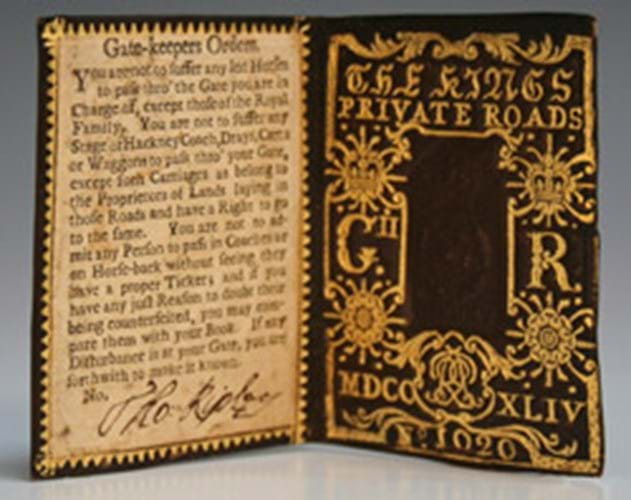
It was something of considerable novelty which drew London and provincial dealers amongst the seven telephone bidders. It was bought at £1800 by the collector Gavin Littaur. The owner of a major collection on postal history, the new bearer of the pass intends now to do some thorough research into its origins.
On one inner cover of the folding calf gilt pass it bears the words 'The Kings Private Roads', the royal cypher G II R, the date in roman numerals and the number 1020.
On the other side is pasted a paper slip headed 'Gate-Keepers Orders', which reads as follows:"You are not suffer any led Horses to pass thro' the Gate you are in Charge of, except those of the Royal Family. You are not to suffer any Stage or Hackney Coach, Drays, Carts or Waggons to pass thro' your Gate, except such Carriages as belong to the Proprietors of Lands laying in those Roads and have a right to go to the same. You are not to admit any Person to pass in Coaches or on Horse-back without seeing they have a proper Ticket; and if you have any just Reason to doubt their being counterfeited, you may compare them with your Book. If any disturbance is at your Gate, you are forthwith to make it known."
At the bottom appears the signature of a Thomas Ripley, which could be the name of the bearer of Pass no.1020, or that of the official issuing the instructions.
The pass was entered for sale by a descendant of the (un-hyphenated) Tyrwhitt Drake family, whose ancestral home was Shardeloes near Amersham, but some readers will also recognise the name, in hyphenated form, as that attached to the Maidstone Carriage Museum.
An assemblage of over 60 vehicles, from royal carriages and sedan chairs to Victorian growlers, governess carts and gigs, this was the collection formed by Sir Garrard Tyrwhitt-Drake, who was 12 times mayor of Kent's county town.
Opened in 1946 and housed in the 14th century stables of the medieval Archbishop's Palace complex, the collection that Sir Garrard gave to the town was the first of its kind in England and remains one of the finest in Europe.
By Ian McKay




